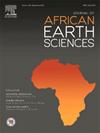Mineralogy and geochemical characteristics of the Ibaga copper ore deposit in Singida-Tanzania: Implication for source of copper mineralization and ore quality
IF 2.2
4区 地球科学
Q2 GEOSCIENCES, MULTIDISCIPLINARY
引用次数: 0
Abstract
The Ibaga copper deposit in the Nzega-Sekenke terrane is hosted in meta-sedimentary rocks and it has been rudimentarily mined by small scale miners for more than a decade. To study mineralogy and geochemical characteristics of the deposit, samples from outcrops and mining pit were collected for XRD, XRF and ICP-MS analysis. Results show that the ore is composed of chalcopyrite, covellite, cuprite, malachite and azurite as ore minerals; whereas augite, chlorite, actinolite, greenalite, birnessite, quartz, magnetite, berlinite, cristobalite, hematite, calcite and parisite are gangue minerals. The deposit is characterized by Cu (3.2–31.3 wt %), Fe (2.1–25.1 wt %), Ag (0.6–16.6 wt %) and lower concentration of penalized impurities Sb, Bi, As, Cd and (Al2O3 + MgO) than threshold limit set by copper smelters and refineries. The ore shows significant variation of Y/Ho = 21.75–40.00, Zr/Hf = 23.33–58.61 and Nb/Ta = 4.20–27.17. Presence of higher REE values of up to 2000 ppm in sample BG04 due to REE minerals known as parisite indicates that the deposit is potential prospect for REE. Consistent with the granites, the ore has Sm/Nd < 0.24 and enriched in LREE relative to HREE where ∑LREE/∑HREE = 4.7–9.0 and La/Lu = 32–769.3. The scatter plot of δCe versus δEu for ore and rock samples suggests closer genetic relationship between the ore, granite and quartz-sericite-schist. These results imply that the granitic intrusion triggered mineralization by skarnification into meta-sedimentary rocks and subsequently the ore underwent supergene enrichment.

求助全文
约1分钟内获得全文
求助全文
来源期刊

Journal of African Earth Sciences
地学-地球科学综合
CiteScore
4.70
自引率
4.30%
发文量
240
审稿时长
12 months
期刊介绍:
The Journal of African Earth Sciences sees itself as the prime geological journal for all aspects of the Earth Sciences about the African plate. Papers dealing with peripheral areas are welcome if they demonstrate a tight link with Africa.
The Journal publishes high quality, peer-reviewed scientific papers. It is devoted primarily to research papers but short communications relating to new developments of broad interest, reviews and book reviews will also be considered. Papers must have international appeal and should present work of more regional than local significance and dealing with well identified and justified scientific questions. Specialised technical papers, analytical or exploration reports must be avoided. Papers on applied geology should preferably be linked to such core disciplines and must be addressed to a more general geoscientific audience.
 求助内容:
求助内容: 应助结果提醒方式:
应助结果提醒方式:


